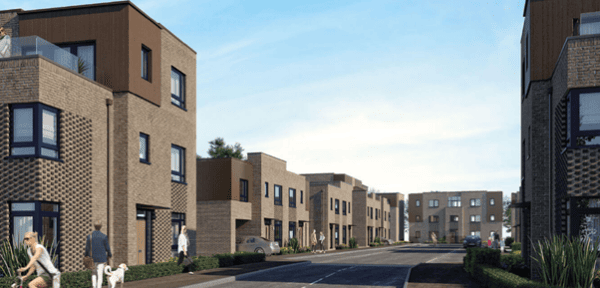What are ‘mixed tenure’ developments and why are they built?.

The term mixed-tenure development usually refers to residential developments where different residential tenures are provided on the same site.
Typically, tenure was split into two broad categories in England; owner occupied and social. However, the private rental sector has steadily been increasing since the 1990’s, creating a third category of intermediate tenures and of course social housing can now cover shared ownership. Hence, the range of possible tenures has increased.
Integrated, segmented or segregated.
Tenures can be mixed to varying degrees, described as either ‘integrated’, ‘segmented’ or ‘segregated’.
- ‘Integrated’ tenure is where properties of different tenure types are side-by-side, and the tenure type is not visually distinguishable from the style of building.
- ‘Segmented’ tenure is a less closely mixed classification, where different types are split, perhaps into separate blocks and/or hold different visual characteristics.
- ‘Segregated’ tenure is where different tenures are kept geographically apart, and such developments can also be referred to as mono tenure.
The popularity of mixed tenure developments
Mixed tenure is far from a new concept, with it forming a prevalent part of the post WWII New Towns movement. However, it has not always been the favoured method for planning new developments.
Notably, during the 1950’s and 60’s – the period that saw the highest rates of new property building in England – segmented, mono-tenure developments were the norm with developments consisting of solely owner occupied or social tenancies.
Since then, mono-tenure developments have become entrenched with criticisms of creating ‘ghettos’ with concentrated areas of deprivation, hindering social mobility, and fuelling stigmatisation toward social housing. This led to a series of government directives to depart from mono tenure and promote mixed tenure again. The current National Planning Policy Framework (England) requires at least 10% of the total number of homes at major residential developments to be affordable.
The impact of mixing tenure
Mixed tenure, by creating communities comprised of different economic groups, has been seen as a solution to combat some of the social problems associated with mono tenure. Thought to foster social interaction between different groups, thereby increasing individual ‘life chances’ of residents and reducing crime and anti-social behaviour.
Equally importantly, a literature review carried out by the National House Building Council (NHBC) Foundation and the Housing and Communities Agency, found that mixed tenure did not have a negative impact on property values. The report stated that in fact, the integrated approach was thought to be most popular with developers for maintaining property value, suggesting concerns that mixed-tenure developments could negatively impact private sector house prices are misplaced.
That said, it should be noted that lenders are usually very cautious around new property developments (whether mixed tenure or not) simply because they have to manage their exposure to risk. Depending on the risk profile of the lender and a range of factors such as general location and untested areas etc. some lenders may only lend on up to 10% of a new development so as not to be over exposed on a site that is ‘untested’ in the market.
What does good mixed tenure look like?
Not all mixed-tenure developments are created equal, and the extent to which the associated positives are actualised will depend on a developments’ general design, including on site amenities, access and care in the way people will ‘live’ in the homes provided. Mixing tenure alone will not promote social benefits. Instead, communities need to be formed of a variety of dwelling types and sizes that are characteristically indistinguishable, designed and laid out to consider the surroundings and encourage interaction.
An example of a mixed tenure development that has strived to meet these demands is Dockley Apartments in Bermondsey, Southwark (pictured in this article). The 111-unit development is comprised of private, shared ownership and social housing tenures (38%), with one, two and three bed options.
Influenced by collective housing in Europe, Dockley Apartments gives priority to communal spaces designed to encourage social connection. Roof terraces, wide galleries and a shared courtyard provide ample space for interaction. While the variety of property types help to establish a stable neighbourhood that caters for different household incomes, sizes and ages. It is plain to see how a development designed in this way, with inclusivity and social interaction at its core, achieves the benefits of mixed tenure.
In an age where a sense of community is diminishing for many, it is important we are increasingly mindful of how we design developments; creating developments that are not just a place to live but a space to interact too.